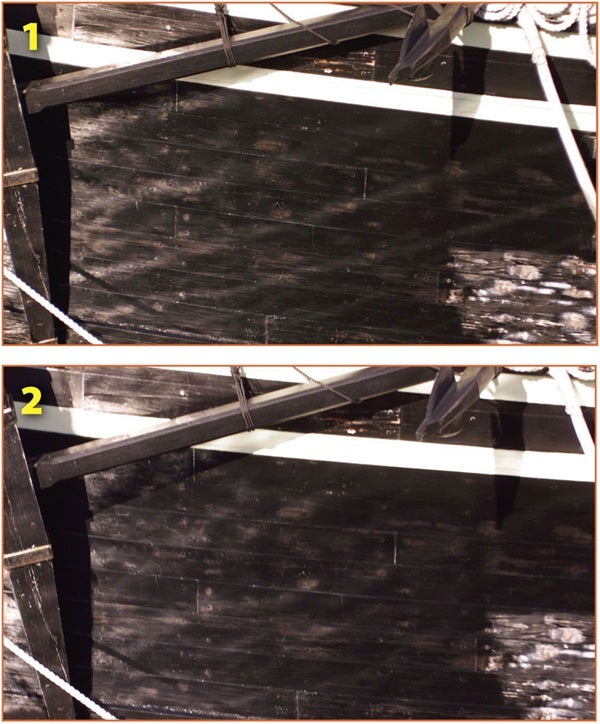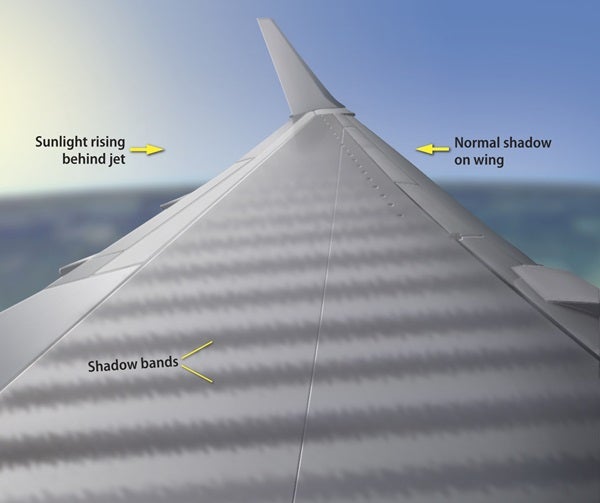The non-eclipse shadow bands I described last month occurred when a flat horizon had partially eclipsed the Sun during its rising or setting. But can you see shadow bands when the Sun is higher in the sky?
One day last September, I was at home on our deck reading a book. The Sun was high in the south and partially eclipsed by a roof, whose shadow fell onto one of the book’s pages. Curious, I opened the book flat to some blank pages and placed it so the roof’s shadow hit it lengthwise and paralleled the bottom of the pages. Then I waited to see what would happen.
To my surprise, I saw shadow bands, about half an inch apart, rippling diagonally across the pages. The air was generally still, with some occasional breezes. Whenever the breezes blew, the bands broke up into a chaotic brew of swirling vapors. These bands, I realized, were from a local atmospheric disturbance: heat rising from the house’s hot tin roof!
“Seeing” effects
Turbulent air, whether it’s local (such as heat rising from hot pavement) or distant (a high-altitude jet stream), can impair the view through our telescopes, causing images to blur, blister, or boil.
The open-ended tubes of classical Newtonian reflectors are also affected by internal tube currents — rushes of warm air rising from the mirror through colder layers in the tube. The ever-moving boundaries between the interacting layers act like weak lenses that deflect incoming rays of light in a most erratic fashion; that’s why it’s important to let a telescope’s mirror “cool down” to the outside temperature before beginning any critical viewing session.
In my experience, fast, high-altitude seeing effects produce long rushing streams of parallel light that make the image appear as if you’re watching it un-der running tap water. Slow seeing effects — those commonly associated with tube currents and local ground-seeing — generally appear as smoky curls and dappled shadows that sway and twirl slowly across the disk.
Heat from your body can also interfere with the air around you and your telescope. And you can see the effects, as Phil McAfee of Johnson City, Tennessee, learned during a partial solar eclipse, presumably January 24, 1925. As reported in a 1936 issue of Popular Astronomy, McAfee saw against a clean white sheet, “the plainly visible shadows of the heat waves rising from my own body, even from the tip of my finger … and hand.”
You too can see heat waves rising from your own body (particularly your head!) anytime when the air is still and the Sun is partially eclipsed, especially by a flat, distant horizon during the times of sunrise or sunset.
Moon shadow
If non-eclipse shadow bands are visible during the day, what about at night, especially during a Full Moon?
Although I have not seen a Full Moon rising or setting behind a flat horizon without clouds since my search for shadow bands began, I did see these serpents of the air at night in October 2008 when the First Quarter Moon was hanging low in the sky. (After all, what is a half Moon on its side but a half-eclipsed Full Moon!)
High-flying shadows
Observations of shadow bands are not confined to Earth’s lower atmosphere. As A. Lawrence Rotch describes in the 1908 Annals of the Astronomical Observatory of Harvard College, a group made the first attempt to see shadow bands at higher altitudes during the August 30, 1905, total solar eclipse.
At Rotch’s request, white screens were hung horizontally below balloons piloted by a corps of military observers in Burgos, Spain. The observers saw shadow bands clearly from at least one balloon at 12,500 feet (4 kilometers). The bands measured about 2 inches (5 centimeters) across, were separated by 3 to 4 inches (8cm to 10cm) — much finer than those detected on the ground — and moved at about 5 feet (1.5 meters) per second.
Can non-eclipse shadow bands also occur high in the air?
On February 1, 2006, I was on a jet that departed Hilo, Hawaii, about 15 minutes before sunrise. As the jet climbed to an altitude of about 14,000 feet (4 km), I saw orange light from the Sun (which was rising directly behind the jet) fringe the forward part of the jet’s silver wing. Suddenly, a dramatic and obvious display of shadow bands covered the jet’s wing.
The bands were perpendicular to the length of the wing and formed thick dark stripes, about 3 or 4 feet (0.9 to 1.2m) across, interspersed with equally wide bright bands. When I focused my attention on a single dark band with direct vision, I saw the band flicker or vibrate rapidly in place; otherwise it did not move. When I used averted vision, all the dark bands seemed to move away from the window toward the wingtip at about 4 feet (1.2m) per second.
Repeating any of my shadow band observations, or searching for new ways to see these phantom serpents of the air, requires only a few minutes. But the reward is worth it. If you’re a teacher, you might want to create experiments with heated air in the classroom to create these curious displays and get kids interested in the playful wonders of the open air. And then send your reports to me at someara@interpac.net.
March 2009: Serpents of the air
See an archive of Stephen James O’Meara’s secret sky












